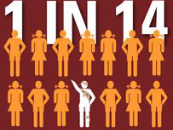Violence in the Classroom
When you decided to major in education, it was likely so that you could develop knowledge in young minds and make a difference in the lives of children. One thing that you likely did not anticipate was potential violence in the classroom. We did received a brief lesson, during our student teaching class, on classroom management, but nothing in the area of bobbing/weaving or “rope-a-doping” to stop a fight.
Some teachers seem content to stand by and allow the students to duke it out; others stop the fight before it even begins, although this can sometimes result in injury to the teacher; still others feel compelled to fight the students themselves. If you find yourself in the position of having to break up a fight, what should you do about violence in the classroom?
The old ways of trying to stop fights are becoming ancient history. Still, John Heiderscheidt, safety and security coordinator for School District U-46, which includes Streamwood High School, says teachers are often the first responders to a fight. Specially trained school resource officers (or SROs), who are usually members of the local police department, patrol school buildings and also respond to safety crises.
Those responsible for safety training in schools are unanimous as to what teachers should not do: Do not get in between two fighting students. “It can escalate the situation,” says Mo Canady, executive director of the National Association of School Resource Officers. “You’re viewed as a combatant. There are a lot of strong kids on campus and you can get seriously injured.”
A range of new policies and training techniques are changing the way schools try to prevent or respond to fighting. Several schools are spelling out the steps teachers need to take when a fight breaks out. Teachers are also being asked to pay attention to behaviors that could lead to fights in the classrooms, hallways or cafeteria. And some districts are turning to outside programs that train teachers how to de-escalate a fight with words rather than force.
Besides a general policy about student safety and discipline, American Association of School Administrators Executive Director Dan Domenech recommends having a more specific policy about intervening in fights so teachers and staff know what they are supposed to do.
De-escalation in practice
De-escalation—a series of deliberate verbal instructions and logistical maneuvers—has become the tool of choice for reducing violence among students in many schools. The Milwaukee-based company, Crisis Prevention Institute (CPI), offers de-escalation training in partnership with school safety consultants like National School Safety and Security Services. CPI’s training approach includes a list of interventions such as:
- Using specific verbal commands to stop a brewing or actual fight
- Dispersing any crowd surrounding an altercation
- Working in teams to separate combatants if necessary
But the first step in handling a fight is for educators to remain calm, says CPI Executive Director of Research Randy Boardman. “Don’t come running and screaming,” he says. Educators should use the first names of the students involved, followed by commands such as “Stop fighting now” or “Clear the hall and go to class right now,” he says. Some educators and experts agree that students will, in fact, respond to instructions from adults, and that students often fight during school—rather than after-hours—because it’s safer: They know the fight is likely to be stopped, possibly even before it starts.
Among other techniques:
- Waiting, if possible, for a team of adults to arrive or for a fight to wane before physically intervening.
- Deflecting blows before they land, by learning how to quickly react and hold up a strong arm to stop a student from hitting another person
- Telling the students they’ve made a good choice when they stopped fighting and thanking them for doing so.
- Taking the combatants to separate areas as soon as possible.
The National Education Association (NEA) supports using basic techniques for school personnel in breaking up fights. They point out that occasionally, arguments between students escalate and erupt into fights. It is important that school personnel know basic techniques for breaking up fights and dealing with students who are physically aggressive. Here are some suggestions from Johns and Carr,1995:
- Never ignore aggression. If ignored, small acts of aggression can quickly grow to more violent aggression.
- Go toward the scene of the violence. Sometimes just the presence of an adult will stop a potentially violent situation.
- Quickly review the situation. Try to determine what has happened, who is there, and what is likely to happen. If the situation includes members of rival gangs, send an onlooker for more adults.
- Look to see if there are any weapons present.
- In a strong voice, tell students that they must stop doing what they're doing. Sometimes students are hoping an adult will tell them to stop fighting so they will have a "graceful" way out.
- Tell any onlookers to leave the area. Call students by name if you know them, and tell them specifically where to go. For example, "Brian, go back to your class now!" is more effective than saying, "Everyone get out of here now!"
- Tell onlookers, and those involved in the aggression, the consequences of not following your directions.
- Make a mental note of the names of onlookers.
- Never get between students who are fighting.
- If the situation does come to blows, tell the students to stop. Sometimes just directing students to stop fighting -- in a loud, demanding voice -- is enough to make them stop. Again, in many cases the students actually are looking for an excuse to stop.
- After the incident, document what happened, and share this with other adults as required.
- Support victims in any way you can. Get them any help they may need.
While many things have changed in the classroom over the last decade or so, many things haven't (and won't). Children need an education in order to be the best adults they can be, especially with the increased demands of employers. By making their success a priority, you will find that your classroom will not only appreciate and respond to your efforts, but you will find more fulfillment and satisfaction with your chosen career.
Reference
District Administration – Squelching school fights- Added awareness, training and practice protect staff and students.
Johns, Beverly H., & Valerie G. Carr. 1995. Techniques for Managing Verbally and Physically Aggressive Students. Hawthorne Educational Services, Inc.
National Education Association – Breaking Up Fights – Basic Techniques for School Personnel: classroom management








